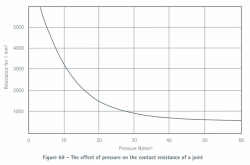DerpsyDoodler
Solar Addict
- Joined
- Jan 10, 2021
- Messages
- 2,247
I don’t know. How much difference would it make at 35 inch pounds?Yeah but won't using it on the nuts effect the torque readings?
I don’t know. How much difference would it make at 35 inch pounds?Yeah but won't using it on the nuts effect the torque readings?
Thanks. Planning on doing this only once. Thought about doing loctite after the fact, just not sure it really is necessary. If I double the nut on the end, really not worth it, I think. I am using nyloc nuts, after all.Wet vs. dry threads while torqueing makes a large difference in clamping force. You can look up tables.
You could torque to spec, then apply loctitie.
If you want to do this more than once, considering the issue of stainless galling and siezing, might want to do it lubricated (possibly with loctite) and adjust torque value lower according to those tables. For other applications anti-seize is recommended.
I messed up a thread big time so i couldn’t even helicoil it. I jb welded a grubscrew in the hole, zero threads. It’s still working fine after 6 months, on high loads 125 amps it voltage drops 0.2v more than the others, and I don’t want to tighten it and risk it breaking. Doesn’t heat up so I don’t worry too much.
I found I had to use very fine sandpaper on all my terminals to stop voltage drop/heating up on ones that even looked ok.
i would guess partially tighter than finger tight, I did use a ratchet.
I used a torque wrench and initially was able to torque to 26.6 inch pounds (3nm). I recently found some of the nuts on my cells a bit loose so while I was tightening them down I tightened down the JB Welded stud a bit more. I don't want to risk tightening it any further. I did not use a torque wrench this time.i would guess partially tighter than finger tight, I did use a ratchet.

Do a gut-check by calculating clamping force, pressure, and looking up resistance per unit area in the linked graph.

Cell terminal bolt torque - you might be wrong!
Anyone got some EVE 280's they want me to play with? ?diysolarforum.com
It almost sounds like you’re trying to blaze trails into the un-unknown.Thanks, but I meant something different.
Greater clamping force results in a lower-resistance electrical connection between tinned lug and aluminum terminal, but only up to a point.
Increased contact surface also results lower electrical resistance in a direct (and linear) way.
So knowing that 35 inch-lbs on M6 is about the highest it makes sense to go in terms of clamping force (however many pounds that translates to @ M6), the question would be which is lower resistance:
25 or 30 inch-lbs on 94.25mm of contact
35 inch-lbs @ M6 on 82.46mm of contact (12.5% less contact surface)?
If increasing from 25 inch-lbs to 35 inch-lbs can reduce contact resistance by more than 12.5%, drilling a larger M8 hole and going that way may be best, but my gut feeling is that no reading torque from 25inch lbs to 35inch lbs is not going to reduce resistance by 12.5% (and in any case, I’ve got no way to measure contact resistance at these levels).
I suppose I could try to use current and measure voltage, at least to compare voltage drop at some reference current like 10A across the entire cell at:
-standard M6 thread @ 25 inch-lbs
-standard M6 thread @ 35 inch-lbs
-standard M6 thread @ 45 inch-lbs
-M6 thread in Helicoil in 15/64” hole @ 25 inch lbs
-M6 thread in Helicoil in 15/64” hole @ 30 inch-lbs (if I decide I need to push things that far).
Have you seen anyone else on the Forum who has attempted to characterize the impact of increased torque / clamping force on contact resistance to the terminal?
A ‘perfect’ 0 Ohm contact should result in ~150uOhm of Internal Resistance meaning voltage drop of ~1.5mV @ 10A versus 0A (at the limit of what my 1mV-precision DMM can measure).
When I’ve tried that dV/dI measurement before, I’ve seen much bigger voltage drops, either because the IR is much greater than 0.15mOhm or I made a crappy connection (or both).
But in any case, I should be able to notice reductions of contact resistance through increased clamping force if they are on the order of magnitude of the specified cell Internal Resistance.
Ever seen anyone try anything similar and/or measure IR using one of those IR meters through lugs / busbars clamped with different torques?
It almost sounds like you’re trying to blaze trails into the un-unknown.
As long as you are using epoxy JBWeld is not really conductive.
How about something like this? Silver conducting epoxy
I’m on mobile otherwise I might go find it but there’s a thread in here somewhere with a graph of contact resistance versus clamping force and it shows a very steep drop off to nearly flat (meaning additional torque is nearly useless) at some point pretty early on.



